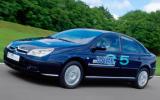When Citroen replaced pedals and mechanical steering with fly-by-wire systems on 2003’s C-Airdream concept, it didn’t seem like much more than a piece of conceptual fancy. Should have paid attention, really, because it might have been good preparation for driving a very real C5 using the same systems.This, says Citroën, is the future, and this car has been built to show off what By Wire can do. Braking is operated by buttons on the wheel and the throttle is also hand-operated. There’s no mechanical connection between steering wheel and front tyres so the wheel could be easily repositioned. This is potentially a revolution in car design; safety benefits include removal of pedals that cause foot injuries and the rigid steering column pointed at the driver’s chest.How does it work? Strangely, but mysteriously well. Behind each hand-grip on the aircraft-style wheel is a squeeze-trigger for the throttle, braking is done by pushing either of two thumb-operated buttons, and the auto ’box looks after itself. Smooth acceleration takes a while to master but isn’t impossible. Braking is less intuitive: there’s half an inch of pedal (sorry, button) travel with all the feedback of a Citroën DS.The steering is remarkably communicative at speed (limited to 43mph) considering all feedback comes via a video-game style torque generator. The ratio is infinitely variable, which is fine in theory but awful in practice: slow for a corner, suddenly three turns are closer to one and you’ve just driven up your own tail pipe.How the steering would work with a manual ’box or a sequential shift is anyone’s guess. But while By Wire is not production-ready, don’t ignore it: it’ll be with us sooner rather than later.Jonathan Hawley
Fascinating technology makes sense for packaging and safety, but will require separate driving schools.
Close











Add your comment